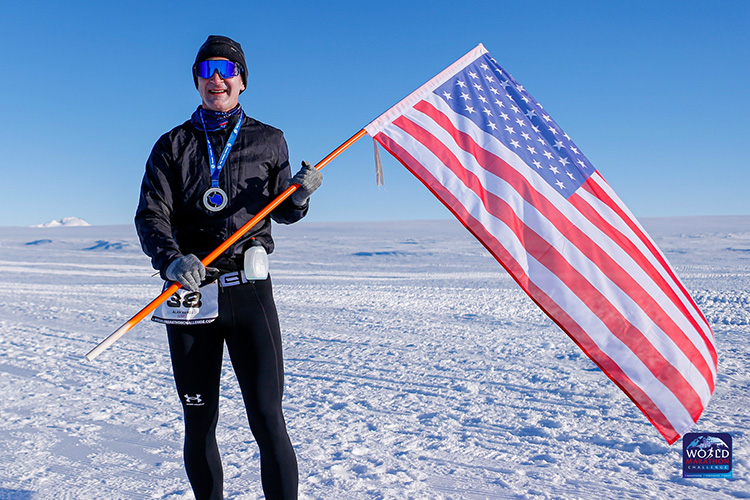
For many runners, the World Marathon Challenge (WMC)—7 marathons on 7 continents in 7 days—is the ultimate test of human endurance, a grueling combination of superhuman stamina, sleep deprivation, and sheer willpower. Which puts it squarely in Alan Nawoj’s wheelhouse.
As a former Guinness World Record holder for fastest aggregate marathon time on all seven continents, Alan already knew a thing or two about running the world. So the 45-year-old San Diego resident, tech entrepreneur, five-time Boston finisher, and father of four couldn’t resist the chance to join 61 other competitors from 20 countries this month for the bucket-list opportunity of a lifetime, starting in Antarctica and finishing six days later in North America (Miami, FL).
When the intercontinental dust settled, Alan represented both himself and the U.S. in impressive fashion. He finished as the top American (out of 25 competitors) and overall second-place male while winning the men’s race on three of the seven continents, including the overall win in Antarctica. Fun fact: His average finish time of 3:25:39 bested American marathon record holder Ryan Hall’s own 2017 WMC average time by nearly 14 minutes. Along the way, Alan raised nearly $6,000 for the Breast Cancer Research Foundation in honor of his late mother Lorraine.
Still basking in the afterglow of a remarkable accomplishment, we caught up with Alan to discuss his whirlwind week—and why he believes the running itself may have been the easiest part.
RR: Alan, thanks for your time and CONGRATS on an absolutely amazing accomplishment; I’d imagine the enormity of it all is still sinking in. While it’s still fresh in your mind (and body!), what are your overall impressions as you reflect on your whirlwind world tour?
AN: Thank you so much, Mike, and I appreciate the opportunity to relive this special event with the RaceRaves community! It’s been less than a week since the World Marathon Challenge (aka “777”) has ended, and I’m definitely still processing what just happened. It was an absolutely crazy week, and I was running on adrenaline the entire time.
As I think back on the 777 adventure, I’m incredibly grateful that my body performed as well as it did, for the outstanding race crew and medical crew, and for the opportunity to meet some amazing, like-minded runners from around the world. The race crew managed the mind-boggling logistics of this event so well that we ended up finishing all 7 marathons in less than 6 days from the start in Antarctica.
This event has clearly shown me the importance of mental toughness in endurance sports and how much potential we truly have when our mind pushes us beyond any physical pain. I’m also humbled by the heartfelt support and camaraderie among the runners in this event.
For instance, I had a friendly battle in each of the races with Paul [Holborn] from the UK / Canada since each of us traded off wins in several of the races. However, when we both struggled in the intense heat and humidity in Brazil for the sixth marathon, we decided to stick with each other and help each other out at the aid stations. In the end, we crossed the finish line together in Brazil, and it was a special moment for me in the journey as a whole.
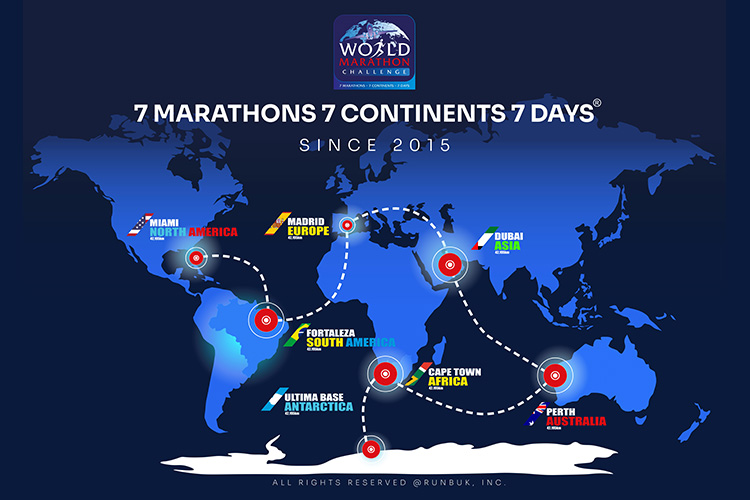
RR: What compelled you to want to run 7 marathons on 7 continents in 7 days?
AN: Like many runners who set a goal and then accomplish it, you’re often left wondering what’s next.
For me, I had already done a number of marathons over the years and came to really enjoy the strategy involved in running this distance as well as the challenges of running in different climates.
I heard about the World Marathon Challenge several years ago and it was always in the back of my mind as something I knew I wanted to do. I saw this endurance competition as the “ultimate challenge” in many ways for a runner, and I wanted to prove to myself that I could do it and compete.
RR: I’d imagine that when you tell someone you ran 7 marathons on 7 continents in 7 (check that, 6!) days, the initial response is disbelief. This was the WMC’s 8th running, and even I still struggle to wrap my head around the concept. How do you prepare for such an epic undertaking?
AN: Training for the World Marathon Challenge is definitely an epic undertaking in itself! One of the hard parts is that there is no standard training plan available for this event like you’ll typically find for other distance races, so you basically need to craft your own training plan that is geared around your specific goals in the event.
I knew I wanted to go for the best time I could deliver in each marathon, so my training plan was very extensive and pretty aggressive. I logged over 3,000 miles in my build up to the World Marathon Challenge, spent countless hours in the gym lifting weights, and then got very serious about recovery strategies after I suffered a calf muscle tear just six months before the event.
The injury caused me to have to rework my entire plan from that point forward, but with a slow ramp and careful rehabilitation, I got myself back to a peak training volume in the low 100s of miles per week.
I focused a lot on my nutrition, as well, since fueling your body for the demands of this event is just as important as the running part. Getting proper sleep and drinking enough water was also key during the training phase, since adequate recovery is crucial when you’re putting such an enormous strain on your body.

RR: To follow up on that: You put in countless hours of training and planning to prepare for this event. With all that prep work under your belt, was there anything that still caught you by surprise or threw you off your game?
AN: Yes, definitely! The jet lag and sleep deprivation impacts during the World Marathon Challenge certainly hit me harder than I expected.
Despite all of the heavy training I did at home, it’s pretty tough to actually simulate the time zone whiplash and true exhaustion that you’ll experience at times during the World Marathon Challenge until you’re actually doing the event itself. Even in my highest mileage training weeks, for instance, I still got to sleep comfortably in my own bed at night and eat foods that I’m used to.
During the 777 journey, we needed to scramble and do the best we could with what was available to us at all times, and that definitely meant sacrificing sleep or eating foods that may not necessarily agree with you completely when you’re rushing from one continent to the next.
The travel schedule we kept was very aggressive, which is why we ended up finishing all 7 marathons in under 6 days, so that also meant not necessarily having the time to mix your own electrolytes before each race or getting in sufficient warm-ups before a given marathon.
RR: Each day you had to run 26.2 miles and then hop on a plane and fly— not to the next city or the next state, but to the next continent — just in time to run another marathon. How did you recover, mentally and physically, under those circumstances?
AN: From a mental standpoint, the schedule moved so quickly that we didn’t really have time to think to be honest!
It’s more like we were in a type of survival mode, so the focus after running was mainly to stick to the routine of getting a shower, eat and drink as much as possible to replenish the calorie burn, do some recovery work such as foam rolling or self-massage, tend to any minor injuries, get your bags unpacked and repacked, and then be ready to board the plane to head to the next continent with the goal of trying to sleep in transit.
Nutrition and hydration were key parts to physical recovery, as was sleep, but none of those were as easy to control as it may seem. We really needed to get comfortable with the fact that we could not control a lot of variables we can typically control before a “regular” marathon and to stay calm.
The charter jet we flew on after marathon number two in Cape Town until we reached Miami was awesome, but sometimes things happen that you don’t really plan for.
For instance, my phone slipped down between the lay-flat seat and the wall of the plane right after we took off from Madrid, and the crew needed to call over a mechanic to start disassembling part of my seat to get to the phone. Normally, it wouldn’t be a huge deal, but I started to get anxious because this unplanned situation was eating into my precious sleep time before the next marathon in Brazil. Finally, after the phone was rescued and the seat was back intact, I needed to take a deep breath and ignore the lost sleep and just try to focus on getting as much sleep as I could from that point forward.
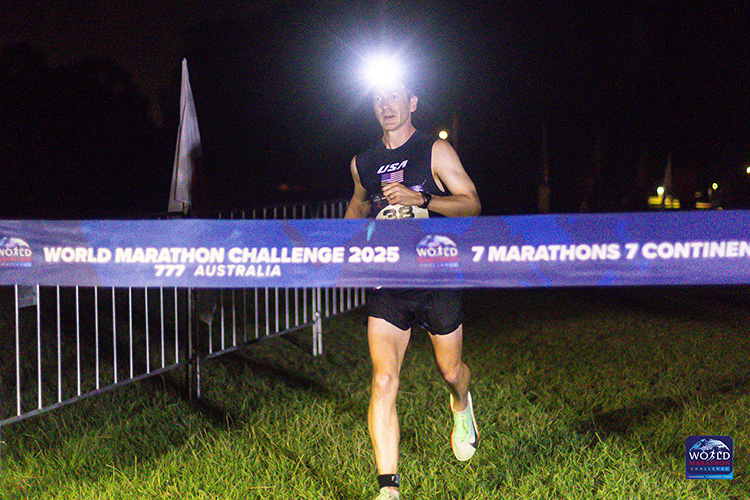
RR: On a related note, how did your body respond to each successive marathon? You didn’t run progressively slower times, as logic might predict; rather, your slowest marathon was day two in Cape Town (Africa), while your fastest was day four in Dubai (Asia).
AN: Surprisingly, my body did quite well after each successive marathon, and it was more about the conditions prior to a given marathon and the weather during that race that really had an impact on finishing times from my perspective.
For instance, Cape Town on day two was my slowest marathon in 3:35 mainly because I literally got zero sleep the night before that race. Never in my life had I run a full marathon, pulled an all-nighter, and then gone directly into a second full marathon less than 24 hours after the first one until this day. Not to mention, it was very hot in Cape Town and there was hardly any shade at all throughout that course. The combination of the heat, no shade, and complete lack of sleep hit me really hard around the halfway point of that marathon, and it was a brutal mental battle to keep pushing forward for me in the second half of that race.
My fastest marathon on day four in Dubai UAE, I believe, was the result of a decent night of sleep while flying from Perth to Dubai which is a pretty long flight, the flat course in Dubai, the cooler evening temperatures, and the intense side-by-side battle for the lead I had with Paul during that race which really kept me fully alert. I ended up with a 3:16 in that one (Editor’s note: and won the men’s race) and somehow found another gear in the last kilometer to kick in a low 6-minute mile until I crossed the line, and I felt great physically.
The decent sleep I then received when flying from Dubai to Madrid along with the cooler temperatures in Madrid helped me pull off another 3:16 finish for Europe despite the big hills on that course.
The most pain or discomfort I felt was typically within an hour or two of finishing because my feet started to swell quite a bit and my legs were reacting to the pounding. However, usually by the time of the next marathon, my body felt well enough to get back out there and start moving again.
The sixth marathon in Brazil was my second slowest, and I believe that was largely due to the intense heat and humidity that we all faced in Fortaleza. It was so hot and humid there that most runners were sweating before the gun even went off. I ran next to Paul for this one, and we actually dunked our heads in the troughs of cold ice water at each aid station to try and stay cool and not overheat.
After Brazil was over, I know many runners were commiserating that they’d rather take the cold of Antarctica over the intense heat and humidity of Brazil any day.
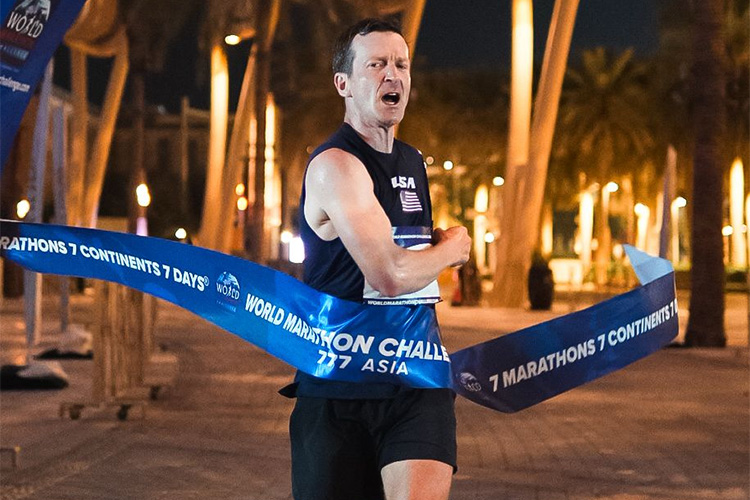
RR: Former WMC finisher Dave McGillivray once noted of the event, “Any time I was running… I was always running for tomorrow. I wasn’t running for today. I’ve got to make sure that I leave enough in the tank for tomorrow.” Did you adopt a similar mindset, or did winning Antarctica on day one embolden a more aggressive approach?
AN: Dave’s comment is absolutely true in the sense that you’ll never run any of the marathons in the World Marathon Challenge at a 100% effort since you need to have enough in the tank to make it through all seven.
With that said, my personal strategy was to run my tank as close to empty as possible and refill it in transit so that I knew I would have left it all out there on the roads when Miami was over. The race crew would often tell us that we should aim for marathon times that are about 30 minutes (or more) slower than your max effort marathon time from a single race with an even greater cushion for Antarctica. In the end, this seemed to be about right, but it’s hard to do an even time for each race across the board due to all of the random variables you can’t control, like sleep, weather, food, etc.
For me personally, the win in Antarctica on day one with a 3:21 did embolden me to take a pretty aggressive approach from that point forward, but within reason. I never went “all out” and never ran at 100% effort since I knew that would end up ruining my next race (except maybe that last kilometer in Dubai 😉), so it was a careful balance to toe the line between high performance and energy conservation.
“I was running on adrenaline the entire time”
RR: No doubt you experienced a number of highs and lows throughout the week, but what were the most exhilarating and most challenging moments, physically or psychologically?
AN: The Cape Town marathon on day two was definitely one of my most challenging moments due to the complete lack of sleep the night before, as was the sauna-like marathon in Fortaleza, Brazil, where I suffered quite a bit in the high heat (low 90s) and very high humidity. Those were both physically and psychologically challenging, and I really needed to do my best to shake those off and put them in the past when moving on to the next races.
On the flip side, crossing the line first in Antarctica on day one and holding the American flag on my victory walk in such a surreal landscape was easily one of the most exhilarating moments for me of the entire 777 journey.
Second to Antarctica for me in terms of most exhilarating moments was the win in Dubai UAE (Asia) due to that intense battle I had with Paul for almost the entire race up until my final surge in the last kilometer. It was an incredible ending under the giant video screen dome at Expo City Dubai and, to top it off, one of my good friends from college who lives in Dubai was there in person to see my finish.
Madrid was another highlight since the course at Jarama Circuit was very hilly (double the elevation gain of the Boston Marathon), and I was happy to hold a steady pace throughout the hills and pull out another 3:16 finish in that one for the win in the men’s race.
Last, but not least, having my family at the start and finish in Miami was certainly a huge highlight of my World Marathon Challenge experience since I got to share those special moments with all of them and also introduce them to several of the other runners I got to know well during our journey around the world.
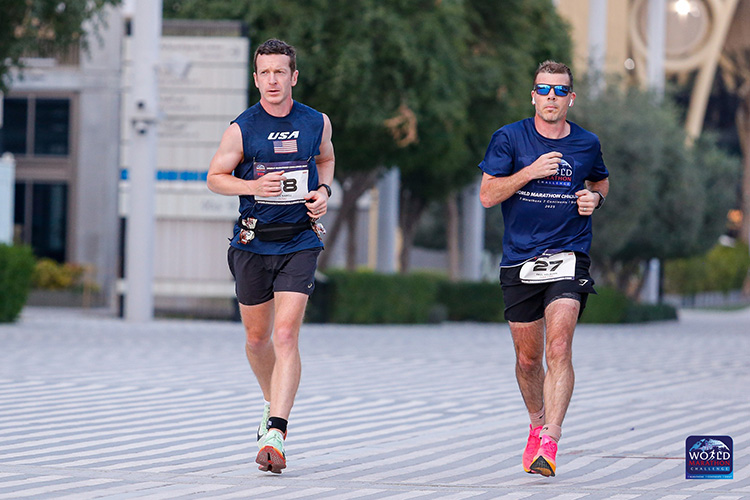
RR: You and I were texting during the event, and your mounting fatigue was palpable in your texts. How did you manage to push through the exhaustion, the caloric deficit, and your bewildered circadian rhythms to keep clocking fast finish times?
AN: The accumulation of jet lag and fatigue was very real, and I think I probably texted you during many of my lower points when I had a few minutes to catch my breath as opposed to the highs.
However, I was pretty surprised at how well my body would then bounce back and essentially be ready enough to start running pretty hard again once the gun went off for the next race. We lost all semblance of day and night during the 777 journey, and “days” would essentially be defined as starting whenever you woke up on the plane at the next continent. It didn’t matter if that was 2am local time or 3pm local time, whenever we landed was basically the start of the next day.
You would do whatever you could to get in calories before going to sleep, try to replenish all of the lost fluids, and then hope to get some sleep and be as ready as possible for the next marathon. For me, it was also just about focusing on the next race and not worrying about anything after that.
Once you start to think about everything in the World Marathon Challenge as a whole, it can be very overwhelming. Instead, I just put all of my mental energy into the next race that was coming and trying to keep myself calm amidst the scattered sleeping and eating I was able to muster.
That first mile of every marathon would often be a bit stiff, but then I noticed how my stride would start to flow more smoothly and I worked myself back into a rhythm. It’s pretty amazing how the human body starts to adapt once it’s placed under extreme stress in an event like the World Marathon Challenge.
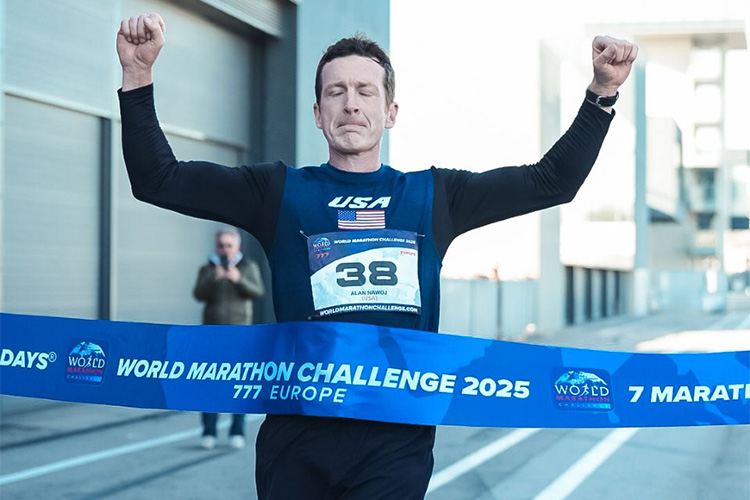
RR: If you could hop in a time machine and give your pre-WMC self one piece of helpful advice, what would it be? Likewise, if someone reading this has their sights set on tackling the World Marathon Challenge, what would you tell them?
AN: If I could step back in time, I would tell myself to adjust my expectations for each race based on how much recovery I received in the previous 24 hours and to realize that my normal pre-race routines would likely not happen and that’s OK.
The running is only a piece of this challenge, and in some ways, the running was the easiest part. It’s everything in between and leading up to each race that can really have an impact on your overall experience, and “going with the flow” is a critical mindset to have from the beginning.
If you’re thinking of tackling the World Marathon Challenge someday, I’d say to absolutely go for it. Give yourself plenty of time to train (at least a full year, ideally), and be realistic with your expectations, whether your goal is just to finish or you are aiming to be competitive.
The physical training will take you most of the way in this challenge, but it’s your mindset that will carry you over each of the seven finish lines. I witnessed runners who got injured part of the way through the event receiving crutches from the medical staff and literally finishing the remaining marathons on crutches. It was a true example of the power of the mind and the sheer will to finish a difficult task that was started.
RR: How would you describe your emotions as you crossed that final finish line in Miami with your family waiting to greet you?
AN: It was a wild mix of emotions crossing the final finish line in Miami, and I’m honestly still processing all of it several days later. Seeing my family there meant the world to me, since they saw me through all of the ups and downs of my long training cycle, including the slow and arduous climb back to regular training following my injury this past summer.
Many of those images flashed before my eyes during the quiet, dark, final mile of that marathon, and it was a surreal feeling. I remember hearing my running app tell me when I reached Mile 25 in Miami, and it hit me that I only had a little over a mile left to go in this epic journey.
The Miami race started just before 1am local time, so all of my running for the seventh and final marathon was entirely in the dark. I could see the bright LED lights from the media crew in the distance as I closed in on the finish line arches, and my first feeling after crossing the line was relief. Relief that I made it through the entire event with no injuries or complications, and relief that I knew I left everything I had out on the roads.
I then felt great joy seeing my family and receiving those final medals around my neck from race director, Becca Pizzi, who did an outstanding job throughout the World Marathon Challenge. It’s a moment I’ll never forget, and there were many tears shed on South Beach that morning.
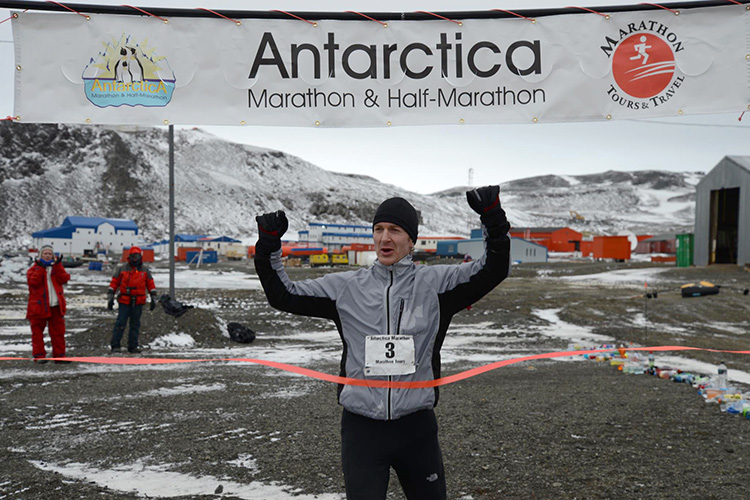
RR: Aside from the athletic accomplishment itself (and that maybe sleep is overrated 😉), what did you learn about yourself over the course of those six days?
AN: A key takeaway from this extreme endurance event for me is that my body was able to bounce back much quicker than I expected between each of the successive marathons, and you can never underestimate the power of a solid training plan and thorough preparation. I knew I had a good base to lean on going into this event, but it was during my lowest moments that it really became apparent to me that my meticulous preparation was serving me well.
RR: What impressed you the most about your fellow competitors?
AN: Despite having some really impressive athletic and professional resumes, what impressed me the most about my fellow competitors was how humble and supportive they were. Everyone was hurting at different times, but it was noticeable how everyone was there to lift each other up.
This was very evident to me during the Brazil race, as I noted previously, when the brutally hot and humid conditions led Paul Holborn and myself to stick with each other from the start all the way through the finish line. We’re both very competitive individuals and had been trading wins on previous continents, but we didn’t even have to say anything to each other that day about sticking together, it just happened and it just felt natural. We suffered together during that one, and we finished together.
During our loop courses for each marathon, it was also nice to high five and cheer on our fellow competitors as we passed each other on the out and backs. Those little head nods and quiet words of encouragement from other runners went a long way for me, and I did my best to return the favor in each race too. In the end, we became a tight-knit group and formed some lifelong friendships.
RR: Any parting thoughts on what must feel like a very surreal six days? And it may be too soon to ask, but any other running-related goals on your bucket list?
AN: Due to the enormity of what went into preparing for this endurance event and the massive effort it took to get through it, I’m actually just focused on enjoying the post-race memories at the moment and letting my body heal and recover… but I know it will just be a matter of time before I start thinking about what my next running goal will be. 😊
👉 Visit Alan’s World Marathon Challenge profile page for more details, final results from the 2025 event, and a link to his donation page for the Breast Cancer Research Foundation.

Alan Nawoj’s 2025 World Marathon Challenge finish times:
Day 1: Novo, Antarctica (3:21:07) 🏆
Day 2: Cape Town, South Africa (3:35:50)
Day 3: Perth, Australia (3:22:33)
Day 4: Dubai, United Arab Emirates (3:16:31) 🥇
Day 5: Madrid, Spain (3:16:40) 🥇
Day 6: Fortaleza, Brazil (3:34:15)
Day 7: Miami, Florida (3:32:40)
Average: 3:25:39
🏆 = Overall winner
🥇 = Men’s winner
All photos (except 2013 Antarctica Marathon) ©️ World Marathon Challenge
Looking for more running events? Search for races by state/city or month, and try our handy Find a Race tool to search for events by name, date range, distance, location, terrain & more. Then sign up for a free account to build your wish list and start coloring in your 50 States Map!
Author: Mike Sohaskey
Mike Sohaskey is the co-founder of RaceRaves, the premier online reviews community for runners to share their race experiences and find their next challenge. Mike honed his creative and critical thinking skills as a research scientist, earning a Ph.D. in Cancer Biology from Stanford. He’s also completed over 100 races — including 50+ marathons and ultras — in locations ranging from Antarctica to Zimbabwe.
Other RaceRaves articles you’ll enjoy (trust us!)
Lunatic Spotlight: 50 States, 7 Continents and 6 Majors
Lunatic Spotlight: More Alike than Different
Lunatic Spotlight: One Year, 100+ Races
Lunatic Spotlight: 50 States the Hard(er) Way
Lunatic Spotlight: Unbreakable
Lunatic Spotlight: Racking up the (s)miles
And for more helpful articles, check out our blog!
Subscribe & Stay Connected
Find this article informative? Please share it, and let others know RaceRaves is the premier online resource to DISCOVER, REVIEW & TRACK all their races and to CONNECT with other runners! Plus, sign up for our newsletter to receive the best racing-related content and special offers every month!
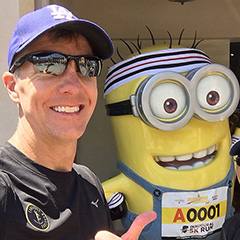
No comments yet